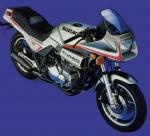Turbos - why they're gone
By Kevin Ash - 29/01/2012
Where have all the turbos gone? In the early 1980s every Japanese manufacturer had a turbocharged bike in its range at some point, and these days more and more cars do.
30 years ago turbos were associated with high performance, but these days they‘re used more for improving efficiency and with that, fuel economy. So will we be seeing them on bikes again?
Not very likely. One problem which is much more acute on bikes than cars is packaging, meaning the problem of fitting an engine and all its associated bits and bobs within a compact chassis. Bikes have become smaller yet engine peripherals have grown: modern exhaust systems have a lot more volume than they used to, along with pre-silencer chambers, catalytic converters, lambda sensors and often EXUP-type exhaust butterfly valves.

On the intake side, fuel injection systems with their pumps and pipes are bulky, and making things worse, modern high power engines have much bigger intake mouths to feed their bigger appetite for air. On the Kawasaki ZX-10R, the intakes are so big they have to be stretched oval vertically so they can fit side by side within the width of the engine!
A turbo meanwhile works best when it‘s fitted as close to the cylinder head as possible, but this space normally is very tight already with the bike‘s watercooling components - radiators are mostly wedged tight between front wheel and motor.
In a modern car turbo the throttle response is much better than it used to be, when you had a big lag between pressing the pedal and the power arriving. But cars are heavy with a much worse power-to-weight ratio than bikes and so are a lot less sensitive to throttle response imperfections, in addition to which, fine throttle control is used on a bike to maintain or change line during cornering. Anything that interferes with this affects handling as well as engine usability, and event he latest electronics couldn‘t help a turbo to match current bikes while staying within emissions regulations.

Cost is another impediment. Cars are built in numbers which are thousands of times higher than bike production, so off-the-shelf turbos that suit car engines are readily available, and building bespoke ones is still cost effective too. But with bikes a specially made turbo becomes too expensive, and most already available are too big for bike engines.
There‘s another argument though: ask a bike designer why he doesn‘t go for a turbo and he‘ll say, if you need more power it‘s far easier to enlarge the engine. Increase the bore and stroke and your engine grows a bit, but it‘s far, far easier to do this than add a turbocharger.
This is current thinking, but as cars get closer and closer to bikes in mpg figures, and bike designers finally start to think in terms of better efficiency rather than more power, maybe then we‘ll start to see compact turbocharged bikes engines. But not for a while yet.
Donate to the Kevin Ash Fund
Kevin's funeral was held on Thursday 28th February 2013 and was well attended by family, friends and colleagues.
The Telegraph has very kindly established The Telegraph Kevin Ash Fund to assist with the education of Kevin's three daughters.
If you'd like to make a donation then you can use the PayPal 'Donate' button below which will allow you to donate from your PayPal account, or via credit or debit card. A small percentage (about 3.4%) will be retained by PayPal for the service.
Kevin's family have been touched by the generosity and messages of support from people using the website and would like to express their gratitude to those who have contributed in any way.
The donations keep coming in, thank you so much, and the family especially like it when you leave a message.
Home | ![]() facebook.com/KevinAshFund
|
facebook.com/KevinAshFund
| ![]() twitter.com/KevinAshFund | © 2012
twitter.com/KevinAshFund | © 2012